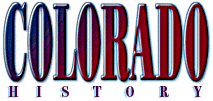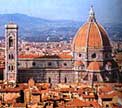|
Highlands Ranch High School - Mr. Sedivy
Highlands Ranch, Colorado

- Colorado History -
Fort Union
By David Sedivy
The New Fort Union - Captain Grover
In the fall 1861, Captain Grover ordered the construction of a new
fort. Shortly after, women and children were removed and sent to Las
Vegas. This fort would be located just east of the original post.
The army anticipated an attack from Texas troops, who at the time
were moving to seize and hold New Mexico for the confederacy. Fort
Union was the main supply depot for the territory. Control of the
fort ment command of all its arms and materiel as well as command
of the Santa Fe Trail and communication with the states.
The first fort was in an indefensible position because of the higher
ground in the rear and both flanks. The idea was to move the post
out of range of field pieces and small arms. Earth fortifications
and entrenchments had well known advantages. The main advantage was
defense. It was said that good troops inside an earthwork could withstand
an attack of three to four times as many equally good troops.19
By January of 1862, nearly all of the quartermasters property, ordnance
stores, and provisions had been moved into the star fort. An article
in Denver's Rocky Mountain News in February 1862, described the star
shaped fort as:
One of the strongest forts in the Western frontier. Its size is seven
hundred and fifty feet square, parapets (an earth embankment to intercept
enemy fire) seven feet high. From the level of the ground on the inside
with a ditch on the outside eight feet deep and fifteen feet wide.
Quarters for two companies built on the insides with a large magazine,
and quarters are built outside the fort in an acute angular form from
the sides of the fort, one each of the four sides with officers quarters
intervening. The ordinance will be put in position early in May. Also
other necessary buildings will be erected as soon as weather permits.
The force at this fort is six companies numbering about three hundred
men.20
Even during the late 1800s the news media gave away military secrets.
However, the confederate troops, had been spying on the fort since
August, 1861.
Confederate Threat
In March of 1862, the threat of the confederate troops became a reality.
Confederate troops in search of supplies and control of the southwest
threatened to invade Fort Union. Union forces stopped the confederate
army at the battle of Glorieta Pass. The battle of Glorieta pass was
the turning point of the Civil War in the far west. Fort Union was
in little danger for the rest of the Civil War. The importance of
Fort Union during that time period still remained high not only because
it was the main supply and munitions depot in the southwest but also
because of the need to keep the Santa Fe Trail open despite Apache
and Navajo uprisings.

A Union recruiter swears in new Indian recruits.
The strategic vulnerability of the star fort was disclosed in June
1862, when the post commander gave a test consisting of a six-pound
and a twelve-pound howitzer pointed at the fort. The six-pounder was
placed at the foot of the hills, and the twelve-pounder was placed
at the crest of the hills above the first fort. Both guns were loaded
with normal charges and shot off. Both guns had the fort in range.
Then in a separate test, a six-pounder was set off from the inside
the star fort, its range only carried half way to the hills.21
The conditions in the first fort and also the star fort (both of
which were still being occupied) were so bad that construction began
in 1863 on the third fort.
The Star Fort
The star fort being built mostly underground had poor ventilation,
lighting and was constantly damp. In addition the pools of water next
to first fort were disappearing and the local springs were drying
up. On October 16, 1866, a huge rainstorm flooded the star fort with
eight to twelve inches of water. A report written by the post surgeon
the following day said all the men were damp. The dampness coupled
with the intermittent storms convinced the surgeon that the incidence
of disease including, fever, rheumatism, and heart complications were
"due in great part to the casemated barracks occupied by the
troops at this post". He told the post commander that the only
way to fix this situation was to repair the old barracks, move into
tents, or move early into the new quarters at third fort.22
After that last flood, the troops moved into tents because nothing
at the third Fort Union had been finished at that time except one
new officers quarters.
By March, 1867, the orders came through to demolish the remaining
buildings known as "Old Post of Fort Union" except those
necessary for housing authorized laundresses and stabling horses and
mules. Any woodwork that could be salvaged from the demolition would
be turned in to the depot quartermaster. The orders stated the "Old
Post" but failed to mention the buildings around the "Old
Post." A report recountered that a number of people still living
in the out lying structures are causing problems. The inspection stated:
"There are always a lot of Mexicans
and unknown Americans harbored around these buildings, Gambling, Drinking,
and Prostitution, seem to be the principle use to which many of these
rooms are appropriated, and soldiers of the Garrison are enticed and
harbored there to carouse all night."23
The Third Fort
In April 1867, these buildings were demolished. Like much of the first
fort, the army salvaged building materials from the fortification,
for re-use in the third fort.
Fort Union
| The Sante Fe Trail and Fort Union |
| Sumner - Ninth Military Department / The
First Fort Union |
| Early Arrivals to Fort Union, Daily Life
at Fort Union |
| Captain Grover - The New Fort Union, the
Confederate Threat |
| Fort Union Arsenal, William Shoemaker,
End of Fort Union |
Bibliography is available by email
request.
Back to the top of page
- Colorado History In Depth
-
Lecture Notes, Reading, and Information:
| The Cheyenne Migration
to Colorado |
| The Gratlan Affair, Massacre, Fort Laramie
Treaty |
The Cheyenne Social Club
| A Cheyenne War Story: Wolf Road, the Runner
|
| Cheyenne Traditions and Beliefs, Sacred
Stories |
| Horses, Warriors, War Pipe, Sweatlodge
Ceremony |
| Cheyenne War Parties and Battle Tactics
|
| The Scalp Dance and Other Cheyenne Dances
|
Americans from the East
| Thomas Jefferson, the Louisiana Purchase
|
| The Expedition of Zebulon Pike |
| Pikes Peak or Bust / Colorado Gold Rush
|
Colorado's Role in the US Civil
War
| The Civil War, Fort Wise / Fort Lyon
|
| Mace's Hole, Colonel Canby, F.C.V.R.
| Fort Weld |
| The Pet Lambs, John Chivington |
| General Henry Sibly, Battle of Valverde,
Fort Union |
Cripple Creek District Labor Strikes
| The Western Federation of Miners / State
Militia |
| The 1893 - 1894 Strike | The
Strike of 1903 - 1904 |
| The Mine Owners Association |
| Crimes and Military Rule in the Cripple
Creek District |
| Marshall Law in Cripple Creek District
/ End of the Strike |
Early Cripple Creek District
| Photos, Fire, and Life in Cripple Creek
|
| Other Colorful Towns in the Cripple Creek
District:
Gillett - Colorado's Only Bullfight, Victor, Independence |
| A Guide to the Miners' Gritty Lingo
|
More Colorado History
Information
| Bent's Fort Photos, Personalities, Plans,
and More |
| What Was Easter Like at Bent's Fort?
|
| Colorado Trivia,
Miscellaneous Old Photos,
Western Personalities, Forts, and More |
| Lullabies for Jittery Cows - Cowboy Ballads
|
| Heraldry of the Branding Iron |
| Project
Aims to Clear Infamous Cannibal, Alferd Packer |
| Lead Gives Alferd
Packer's Story More Weight |
| Legendary
Colorado Love Stories: Baby Doe Tabor & More
|
| Colorado Pioneer Women: Elizabeth Byers
|
| Early Denver Jokes / The History of April
Fools' Day |
Back to the top of page
|



![]() 9375 South Cresthill Lane
9375 South Cresthill Lane ![]() Highlands Ranch, Colorado 80126
Highlands Ranch, Colorado 80126 ![]() 303-471-7000
303-471-7000

